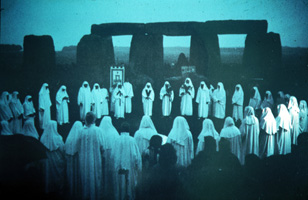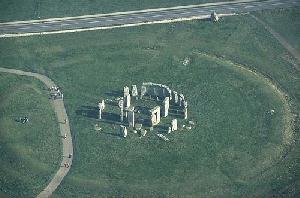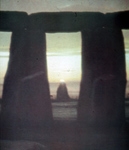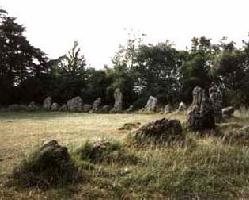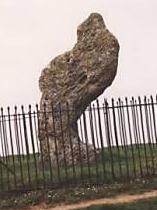![]()
![]()
![]()
![]()
On Page 2 you will find 'Potions and Lotions'
On Page 3 is 'Food and Drink'
![]()
|
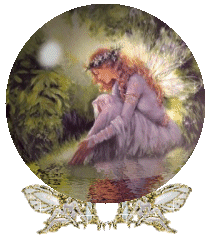 |
![]()
The Summer Solstice itself falls on June 21st and is the longest day of the year when the sun reaches it's highest point in the sky. The word solstice comes from the Latin word sol meaning sun and stice meaning to stand still.
This was originally the day on which people celebrated Midsummer. With the coming of Christianity, Midsummer celebrations were moved to the feast of St John the Baptist on 24th June. This is a mirror of the Winter festivities where the Winter Solstice falls on December 21st, and the Christmas celebrations begin a few days later on December 24th.
![]()

One of the most famous Summer Solstice celebrations occurs annually at Stonehenge, the ancient stone circle on the Salisbury Plain in Wiltshire England.
| On the night
before Midsummer, a group of white-robed Druids gather at
Stonehenge to watch the sun rising. Exactly when the Ancient Order of Druids
began their annual Summer Soltice celebrations at
Stonehenge is not known, but for the past hundred years
at least, it has become an annual event. Due to immense damage caused by tourists, the stones are now only able to be viewed from a specially built pathway, as can be seen from the aerial view of Stonehenge. However, In the past few years, these special 24 hours of Midsummer's Eve and Day have also become the one time annually when anyone can actually walk amongst the stones themselves, and many pagan groups now conduct their own rituals there during Midsummer as a result |
|
|
As it comes up, the sun rises exactly over the Heel Stone, one of the stones that lies outside the main circle at Stonehenge. As well as this, the axis of Stonehenge, which aligns with the monument's entrance, is oriented in the direction of the Midsummer sunrise. |
Stonehenge itself is 5000 years old and despite popular beleif, it is certain that the Druids had nothing whatsoever to do with the construction of the stone rings. The Celtic society in which the Druid priesthood flourished came into existence in Britain only after 300 BC, more than 1500 years after the last stone rings were constructed. Furthermore, no evidence suggests that the Druids, upon finding the stone rings situated across the countryside, ever used them for ritual purposes; they are known to have conducted their ritual activities in sacred forest groves.
![]()
![]()
| Midsummer is
a time of magic and faeries. Shakespeare's play 'A
Midsummer Night's Dream' typifies the atmosphere of this
night when the veil is thinnest between our world and the
Faerie Realm. Children and psychics can see faeries at
any time and in any place. But for most mortals,
Midsummer Eve at dusk, especially if the moon is full, is
the best fey time of all. Don't sit underneath a hawthorn on Midsummer's Eve or you will become enchanted by the faeries. Single thorns growing near faerie hills and those in threes are especially magical. |
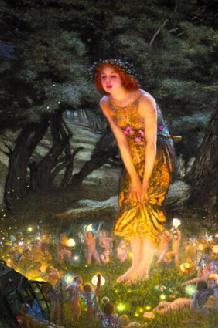 |
If you want to attract faeries to your garden, you also need to keep on good terms with them. Never uproot or kill an established plant or tree and when you remove what are known as 'weeds' never do it when the plants are in bloom. Leave them to compost naturally so that their goodness goes back into the nature instead of burning them in bonfires and polluting the atmosphere. Talk to your plants as you tend to them and encourage them to grow.
To work a faerie
spell, pick vervain, yarrow, mistletoe, rue, thyme and bay. Dice
each leaf and bake them into a little oat cake which must be
sweetened with honey and 3 drops of rose oil. Take it freshly
baked at the time of the full moon or moon rise on Midsummer's
Eve and place it under a tree or bush in a little wild spot in
your garden or just beyond it. Bless the cake and say:
Faeries the work of my spirit I give thee
Be lovers true to my garden, I bid thee
You will know if your craft is good because your flowers
will be more radient and your whole garden will grow better. You
will also start to notice the evidence of a faerie presence in
your garden.
 |
A ladybird
with seven spots on it's back is a faerie's pet and you
may make three wishes before it flies away. Thistledown and dandelion clocks transport faeries. In return for sending a faerie on it's way you may have a wish. |
![]()
![]()
Midsummer Day and the time immediately preceding it is believed to have special powers. Medicinal herbs collected from June 1 to the Midsummer Day can cure 12 (some say 99) diseases.
If a girl wants to know who she will marry , she should pick seven different flowers, put them under her pillow on Midsummers Eve, and then she will dream about him.
| One of the
most powerful plants used at Midsummer was St John's Wort.
People used it in potions, and wove the flowers into
garlands to decorate their houses or protect their farm
animals. They believed that the herb could shield them
from the power of evil spirits and could help them
foretell the future. St John's wort, the yellow herb of Midsummer has divinatory powers. If gathered at dusk by young maidens who have fasted all day and placed beneath their pillows, the herb promises dreams of true love. |
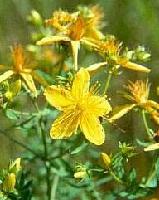 |
On Midsummer Day morning, witches acquire special powers to affect cows milk by bewitching the dew. To save their cows from the witches magic, farmers shut them in cowsheds for the Midsummer Night and stick bunches of nettle in the door to scare the witches away. On Midsummer Day, the cows are driven out to pasture only in the early afternoon when there is no more dew on the grass.
 |
There are numerous legends about the fern plant which is said to come into blossom only at Midnight on Midsummer Eve. Whoever finds a fern blossom becomes a wise, rich and happy person. Anybody who wants to find a fern blossom must spread a white cloth under the clump for the blossom to fall onto, draw a circle around oneself with a rowan stick hallowed in church, light a candle and pray in defiance of the monsters around. The blossom that drops onto the kerchief looks like a speck of gold and must be held closely incase anyone should try and steal it. |
![]()
![]()
| A tall pole
with a wooden cartwheel bound with straw and soaked in
tar, was taken to the highest hill in the area. The wheel
was then set on fire and bonfires were lit around it.
Young people used to jump through the flames much in the
same way as they did with the Beltane fires some weeks
earlier and barren cows were driven through the fires. The burning wheel was then rolled down the hill which often had a river or lake at it's foot. If the flames were extinguished before it reached the bottom, a poor harvest was expected, but if the flames continued to burn vigorously, then the harvest would be good. |
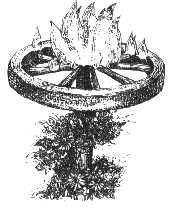 |
Burning wooden torches were also carried around the fields to promote a good harvest,
In Scandenavia, many bonfires are lit on Midsummers Eve still, and this is considered to be a holiday which is now celebrated on the Friday and Saturday between the 20th and 26th of June. Officially it's to commemorate John the Baptist.
![]()
![]()
The tree is a strong fertility symbol. In one aspect it is 'the earth phallus', the male principle jutting out of the earth, while as the fruit bearing tree of life, it is female. In some parts of the world, resin from coniferous trees was regarded as the Earth Mother's menstruation.
The witch-elder is said to be in a hedge between the King Stone and the Stone Circle, and if cut when in blossom it will bleed. It was tradition for people to gather round the King Stone on a Midsummer's Eve - when the elder tree (the witch) was cut, the sap (or the witches blood) used to run out and the head of the King Stone was said to move. The King Stone is also supposed to walk to a nearby spring at midnight for a drink. |
Bleeding elder trees are usually thought to be witches in disguise, like the famous tree near the Rollright Stones in Oxfordshire, England. A witch turned a King and his army into standing stones, and she herself became an elder tree.
|
It is also the custom in Scandenavia to dance around 'Midsummer Poles' at Midsummer much the same way as is done around Maypoles at Beltane. Huge crosses called a "midsommarstoeng" are also built. The branches from birch trees are used to build the structure, then it is covered with leaves and flowers.
This practise was not only confined to Scandenavia, in parts of Wales, a flower-decked birch tree would be set up for dancing around on Midsummers Day, the dancing continuing for several days if the weather was good.
Holy trees are believed to protect the area where they grow. It is traditional to honor trees by decking them with rags, ribbons or flags. Ancient tree dressing ceremonies still take place in a number of places in England. During the Midsummer ceremony of 'Bawning the Thorn Tree' at Apperley in Cheshire, the hawthorn tree is decked with red ribbons.
![]()
![]()
The ceremony of Well dressing is a tradition peculiar to the County of Derbyshire in England, that takes place throughout the summer months. It is the art of decorating wells or springs, and sometimes other sources of water such as taps, or where wells used to stand, with natural growing materials.
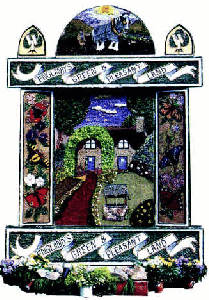 |
Well dressing was originally known as 'Well
Flowering' and is thought to have originated from Pagan
times, as a ritual performed to give thanks for the
supply of fresh water, and probably evolved from
sacrifices to water gods in thanks for supplying water in
the past and in the hope of this continuing in the future.
Over time, garlands of flowers replaced the sacrifice of
humans or animals. The
fact that many well dressings have a 'Well Queen'
suggests echoes of ancient fertility rites. Some other sources attribute the practice to the period of the Black Death in 1348-9, when probably a third of the population of England died of the disease, but some villages such as Tissington were untouched. The local people attributed this to their clean water supply and gave thanks by 'dressing' the village wells. |
| However Well
Dressing began, the worship of fountains was forbidden by
the early Christian Church in 960 AD and St. Anselm was
still condemning it early in the 12th century. So it is
probable that 'Well Rituals' were originally pre
Christian practices that continued, only becoming
accepted by the church during the plague years, as a way
of thanking God for deliverance instead. Today the custom has strong religious connections and approximately 75% of pictures have a religious theme. Non-religious themes often reflect a local topic or National Anniversary. |
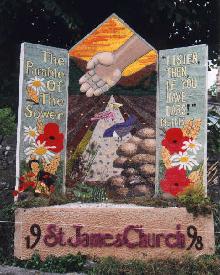 |
The well dressing is constructed on a wooden tray onto which a layer of wet clay is pressed. A design is drawn and its outline pricked out onto the surface of the clay. The pattern is emphasised further by pressing in a variety of plant parts such as berries, reeds or alder cones. The design is then realised by pressing thousands of flower petals into the clay, using different coloured petals for the various sections of the design.
A well dressing has a very limited lifespan, so the design has to be put together very quickly, usually only a couple of days before the well dressing is due to be erected, and often almost the whole village will be involved.
Finally the completed frame and picture are assembled adjacent to the well or other water supply. After the well dressing is erected next to the well it is blessed in a short outdoor service, and usually a brass band will be hired for the occasion. Since many of the towns and villages have several wells, there will then be a procession around the town to bless each one in turn. The well blessing ceremony is usually the signal for the start of a week of celebrations (or 'wakes') with a range of events culminating in a carnival at the end of the week.
The well dressing will usually stand at the well for a week, by which time the clay will be drying out and cracking and the petals fading.
![]()
![]()
![]()
![]()
![]()
On Page 2 you will find 'Potions and Lotions'
On Page 3 is 'Food and Drink'
![]()


